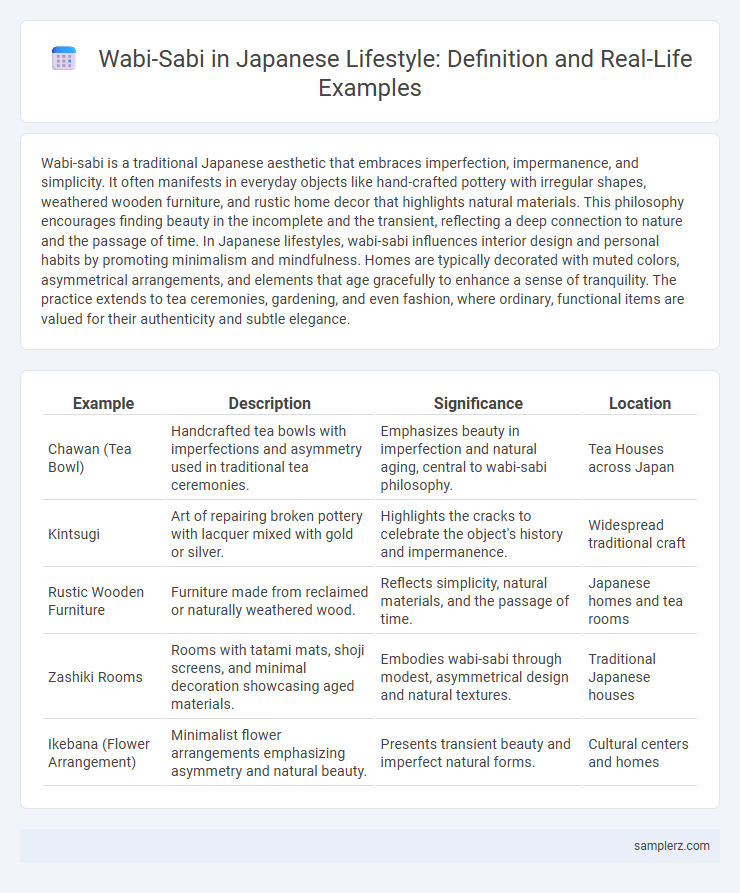Wabi-sabi is a traditional Japanese aesthetic that embraces imperfection, impermanence, and simplicity. It often manifests in everyday objects like hand-crafted pottery with irregular shapes, weathered wooden furniture, and rustic home decor that highlights natural materials. This philosophy encourages finding beauty in the incomplete and the transient, reflecting a deep connection to nature and the passage of time. In Japanese lifestyles, wabi-sabi influences interior design and personal habits by promoting minimalism and mindfulness. Homes are typically decorated with muted colors, asymmetrical arrangements, and elements that age gracefully to enhance a sense of tranquility. The practice extends to tea ceremonies, gardening, and even fashion, where ordinary, functional items are valued for their authenticity and subtle elegance.
Table of Comparison
| Example | Description | Significance | Location |
|---|---|---|---|
| Chawan (Tea Bowl) | Handcrafted tea bowls with imperfections and asymmetry used in traditional tea ceremonies. | Emphasizes beauty in imperfection and natural aging, central to wabi-sabi philosophy. | Tea Houses across Japan |
| Kintsugi | Art of repairing broken pottery with lacquer mixed with gold or silver. | Highlights the cracks to celebrate the object's history and impermanence. | Widespread traditional craft |
| Rustic Wooden Furniture | Furniture made from reclaimed or naturally weathered wood. | Reflects simplicity, natural materials, and the passage of time. | Japanese homes and tea rooms |
| Zashiki Rooms | Rooms with tatami mats, shoji screens, and minimal decoration showcasing aged materials. | Embodies wabi-sabi through modest, asymmetrical design and natural textures. | Traditional Japanese houses |
| Ikebana (Flower Arrangement) | Minimalist flower arrangements emphasizing asymmetry and natural beauty. | Presents transient beauty and imperfect natural forms. | Cultural centers and homes |
Embracing Imperfection: Wabi-Sabi in Japanese Architecture
Japanese architecture exemplifies wabi-sabi through its celebration of natural materials like weathered wood and imperfect stone, highlighting the beauty found in irregular shapes and textures. Traditional homes often feature asymmetrical layouts and handcrafted elements that age gracefully, embodying impermanence and authenticity. This aesthetic philosophy encourages simplicity, tranquility, and acceptance of life's transient nature in living spaces.
The Beauty of Aged Teaware in Japanese Tea Ceremonies
Wabi-sabi in Japan is epitomized by the beauty of aged teaware used in traditional tea ceremonies, where imperfections and weathered surfaces symbolize impermanence and natural simplicity. These timeworn ceramics, often featuring subtle cracks and faded glazes, enhance the sensory experience by connecting participants to the passage of time and the philosophy of embracing transience. This appreciation for aged teaware reflects a deeper cultural reverence for authenticity and the imperfect elegance inherent in natural materials.
Natural Materials and Simple Design in Wabi-Sabi Homes
Wabi-sabi homes in Japan emphasize natural materials such as unfinished wood, bamboo, and clay, reflecting the beauty of imperfection and aging. Simple design features like tatami mats, shoji screens, and minimalistic furniture create tranquil spaces that celebrate asymmetry and organic textures. This lifestyle promotes mindfulness and appreciation for the natural cycle of growth and decay within the living environment.
Celebrating Transience through Japanese Ikebana
Wabi-sabi, a Japanese aesthetic appreciating imperfection and impermanence, is beautifully expressed through Ikebana, the traditional art of flower arranging. Ikebana emphasizes asymmetry, natural form, and the mindful selection of seasonal blooms, reflecting the transient nature of life. This practice encourages mindfulness and acceptance of ephemerality, celebrating beauty in decay and change.
Weathered Gardens: Nature’s Role in Wabi-Sabi Aesthetics
Weathered gardens in Japan exemplify wabi-sabi by embracing natural aging and imperfection through moss-covered stones, uneven pathways, and weathered wooden structures. These elements highlight the transient beauty of nature, emphasizing simplicity and authenticity in garden design. The subtle changes brought by seasons and weather contribute to the dynamic, ever-evolving charm central to wabi-sabi aesthetics.
Wabi-Sabi in Everyday Japanese Tableware
Wabi-sabi in everyday Japanese tableware emphasizes simplicity, natural materials, and imperfection, often seen in handmade pottery with uneven edges and subtle glaze variations. This aesthetic celebrates the beauty of aging and the organic textures of wood, ceramics, and stoneware used daily in Japanese homes. The quiet elegance of wabi-sabi tableware encourages mindfulness and appreciation for transient beauty during meals.
The Charm of Faded Kimonos and Handcrafted Fabrics
The charm of faded kimonos in Japan embodies the wabi-sabi aesthetic, celebrating imperfection and transience through their worn textures and muted colors. Handcrafted fabrics, often dyed with natural pigments and stitched using traditional techniques, reflect the beauty of aging and the craftsmanship behind each piece. These textiles highlight an appreciation for simplicity, humility, and the passage of time, central to the Japanese wabi-sabi philosophy in lifestyle and design.
Asymmetry and Minimalism in Japanese Art
Wabi-sabi in Japanese art embraces the beauty found in asymmetry and minimalism, highlighting imperfection and simplicity as core aesthetic principles. Traditional ceramics and ink paintings often showcase uneven forms and sparse compositions, reflecting a natural, unpretentious elegance. This approach celebrates the transient and imperfect nature of life, contrasting with Western ideals of symmetry and excess.
Nostalgia in Japanese Folklore and Wabi-Sabi Philosophy
Wabi-sabi in Japanese lifestyle embraces the beauty of imperfection and transience, often reflected in nostalgic elements of Japanese folklore such as weathered tea houses and faded kimonos that tell stories of the past. This philosophy values simplicity, asymmetry, and natural wear, highlighting the charm found in age and impermanence. Nostalgia in this context serves as a bridge between cultural heritage and mindful appreciation of life's fleeting moments.
Finding Wabi-Sabi in Daily Rituals and Japanese Mindfulness
Wabi-sabi in Japan reveals itself through daily rituals such as sipping matcha tea, where the imperfect ceramic bowl and the deliberate, slow preparation embody simplicity and natural beauty. Japanese mindfulness embraces transient moments like the quiet appreciation of a weathered wooden veranda or the subtle asymmetry of a hand-folded origami, emphasizing acceptance of imperfection and impermanence. These practices cultivate a serene lifestyle that values authenticity and understated elegance in everyday experiences.

example of wabi-sabi in Japan Infographic
 samplerz.com
samplerz.com